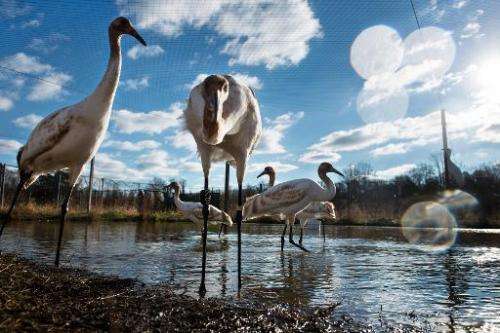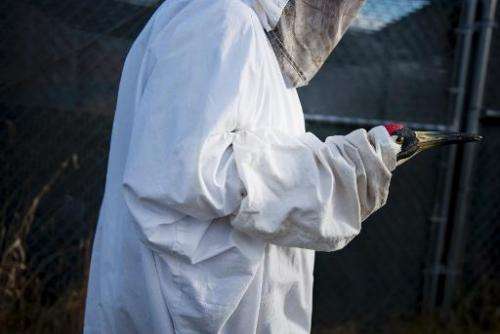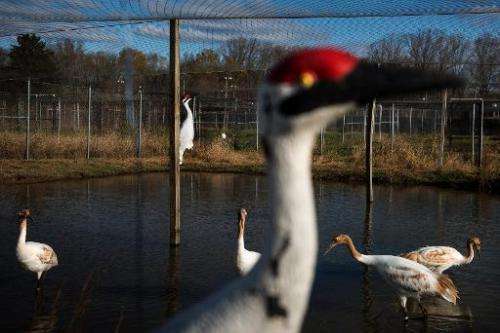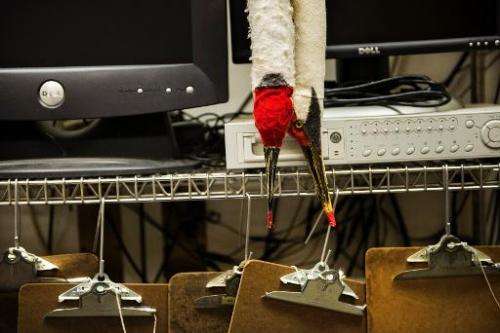Rare whooping cranes in US face enemies large and small

Jane Chandler raises the rarest cranes in the world. For them to have a chance at surviving in the wild, the young birds must never see her face, hear her speak, or know her to be a human being.
If they did, these whooping cranes, named for their characteristic calls, would come to think of themselves as human. Then they would not find a mate in the wild, or understand the true danger that people represent.
So Chandler dons a disguise whenever she comes near the chicks.
Her bird suit is made up of a sheet-like drape that covers her from neck to ankles, and a full white head covering with a camouflage screen hiding her face. She wears a puppet of a crane's head on one hand, using the beak to pick up food pellets, grapes, mealworms or corn to feed the young birds.
Chandler's title is Crane Flock Manager at the US Geological Survey's Patuxent Wildlife Research Center, and on a crisp morning in November, her charge was a group of 11 juveniles.
Nearly six months old, they stand about three feet (one meter) high. Their heads and wings are light brown, a hue that will fade as they become adults, giving way to sleek white plumes, black-tipped wings and a scarlet crown.
These iconic North American birds poke around their outdoor enclosure, walking delicately through a pond, flapping their wings occasionally, pausing to peck corncobs and squeaking in response to the throaty sounds of adult cranes nearby.
Soon, they will be packed up and sent via private aircraft to their new home, added to a group of 23 captive-bred counterparts at the White Lake Wetland Conservation Area in Louisiana.
"Historically there was a non-migratory flock in Louisiana in the 1900s," Chandler says. "So we are trying to recreate that."
Whooping cranes all but disappeared from the United States more than a century ago. The tallest birds in North America, reaching up to five feet, they were hunted to the brink of extinction and lost critical habitat in the 1800s when pioneers drained their freshwater marshes for farmland.
By the 1940s, the only remaining wild population was down to around two dozen birds.
Now, after five decades of efforts and millions of dollars spent annually to rebuild their numbers, there are nearly 600—about 300 in the wild and the rest in captivity.
Conservationists say a sustainable population would have 1,000 wild birds, in at least two independent flocks.
Two of the four major efforts to reintroduce the Grus americana to the wild have failed since the 1960s. A third is struggling so much that experts are questioning whether it is even possible to bring them back to places from which they have vanished.

"Is reintroduction a valid tool for conservation?" asks Jeb Barzen, director of field ecology at the International Crane Foundation.
"It is a critical question we are engaged with."
Chicks are not surviving in a key population of captive-bred whooping cranes that have been set free since 2001 at a wildlife refuge in the midwestern state of Wisconsin.
These cranes are meant to migrate south toward Florida, serving as a second wild population to the existing flock that travels between Wood Buffalo National Park in Canada and Aransas National Wildlife Refuge on the Gulf Coast of Texas.
They learn to fly by following human pilots in bird suits aboard a one-seat ultralight aircraft, run by a non-profit group called Operation Migration.
The cranes begin pairing off, making nests and laying eggs by the time they are four to five years old.
But nearly all these attempts in Wisconsin have failed. Of 132 nests counted from 2005 to 2013, 22 hatched at least one chick. Only five of those chicks survived one year, says USGS research ecologist Sarah Converse.
Often, the birds were getting up off their nests before their eggs could even hatch. But why? For years, it remained a mystery.
"We now think that it is very likely because of the harassment of birds by biting black flies," says Converse.
"They are incredibly irritating and painful, and they bite and draw blood."
Conservationists scouted some new places for release nearby, where the bird-attacking black flies are less common, and began releasing whooping cranes there in 2011.
Another new approach is having cranes, instead of humans in bird costumes, raise some of the chicks born in captivity.

In the wild, whooping cranes spend up to a year with their parents before they go off on their own, learning behaviors to help them survive.
"There may something lacking that we are not giving them," says USGS chief veterinarian Glenn Olsen.
This year, four young birds were brought up this way and released in Wisconsin near adult whooping cranes.
Two died within weeks. One was hit by a car. The other was killed by a large predator, likely a wolf or a coyote.
The two survivors formed bonds with adult birds and migrated south with them.
Despite the 50-50 outcome, Olsen calls the project "very successful," and said next year six to nine chicks will be raised and released this way.

But he says this approach will never replace the need for costumed human parents like Chandler, who has worked at Patuxent for 25 years.
She says a high point of her job is when she occasionally gets to see the birds flying free in the wild.
Though she must stay invisible to the birds, she forms strong bonds with them on the protected Maryland refuge, where cranes in captivity can safely reach old age.
"Some of the birds that I work with have also been here for 25 or even 40 years—our oldest bird is 42. When one of those birds dies, it is sad," she says.
"It is like losing a friend."
© 2013 AFP

















